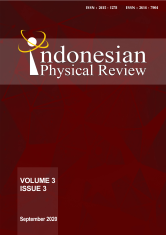STRUCTURAL AND MORPHOLOGICAL INVESTIGATION OF FUNCTIONALIZED REDUCED GRAPHENE OXIDE-MULTI WALLED CARBON NANOTUBES NANOCOMPOSITE
DOI:
10.29303/ipr.v3i3.61Downloads
Abstract
2D materials like Graphene and its composite has emerged as most valuable and major concern because of their peculiar properties in field of nanotechnology in past few decades. Herein, we report the effective technique for the synthesis of functionalized r-GO/MWCNTs nanocomposite using probe sonication. The synthesized samples were tested via XRD, FESEM, FTIR and Raman Spectroscopy. X-ray diffraction technique was used for the structural analysis of the samples which revealed that most prominent peak was observed around 2θ~26°. Surface morphology of the samples were studied via FESEM, which revealed that r-GO layers were wrapped around the MWCNTs. Raman spectra were recorded for the determination of quality of r-Go and MWCNT via the position and intensity of D and G band. The various functionalities present on the samples were identified via FTIR spectra.Keywords:
r-GO MWCNT XRD FESEM FTIR Raman SpectroscopyReferences
S.K. Misra, P. Kondaiah, S. Bhattacharya, C.N. Rao (2012). Graphene as a nanocarrier for tamoxifen induces apoptosis in transformed cancer cell lines of different origins. Small (8), 131–143.
K.S. Novoselov, A.K. Geim, S.V. Morozov, D. Jiang, Y. Zhang, S.V. Dubonos, I.V. Grigorieva , A.A. Firsov (2004). Electric field effect in atomically thin carbon films. Science 306, 666–669.
S. Shintaro (2015). Graphene for nanoelectronics. Jpn J Appl Phys 54, 040102.
C.S. Park, H. Yoon, O.S. Kwon (2016). Graphene-based nanoelectronics biosensor. Journal of Industrial and Engineering Chemistry, 38, 13-22.
L.M. Hollanda, A.O. Lobo, M. Lancellotti, E. Berni, E.J. Corat, H. Zanind (2014). Graphene and carbon nanotube nanocomposite for gene transfection, Materials Science and Engineering C, 39 288–298.
N. Kumar, B.K. Gupta, A.K. Srivastava, H.S. Patel, P. Kumar, I. Banerjee, T.N. Narayanan, G.D. Varma (2015). Multifunctional two-dimensional reduced graphene oxide thin film for gas sensing and antibacterial applications. Sci Adv Mater 7, 1125–1136.
S.J. Cartamil-Bueno, A. Centeno, A. Zurutuza, P.G. Steeneken, H.S.J. van der Zant, S. Houri (2017). Very large scale characterization of graphene mechanical devices using a colorimetry technique. Nanoscale 9, 7559–7564.
C.J. Hung, P. Lin, T.Y. Tseng (2013). Electrophoretic fabrication and pseudocapacitive properties of graphene/manganese oxide/carbon nanotube nanocomposites. J Power Sources 243, 594–602.
Md. Sajibul Alam Bhuyan, Md. Nizam Uddin Md. Maksudul Islam Ferdaushi Alam Bipasha, Sayed Shafayat Hossain (2016). Synthesis of graphene, Int Nano Lett 6, 65–83.
Jo J et al. (2019). Facile synthesis of reduced graphene oxide by modified Hummer’s method as anode material for Li-, Na- and K-ion secondary batteries. R. Soc. open sci. 6, 181978. http://dx.doi.org/10.1098/rsos.181978
Fangzhu Qing, Yuting Hou, Richard Stehle, and Xuesong Li (2019). Chemical vapor deposition synthesis of graphene films, APL Mater. 7, 020903 ; doi: 10.1063/1.5078551
N. Parveen, S.A. Ansari, S.G. Ansari, H. Fouad, M.H. Cho (2017). Intercalated reduced graphene oxide and its content effect on the supercapacitance performance of the three dimensional flower-like β-Ni(OH)2 architecture. New J Chem 41, 0467–10475.
License
Authors who publish with Indonesian Physical Review Journal, agree to the following terms:
- Authors retain copyright and grant the journal right of first publication with the work simultaneously licensed under a Creative Commons Attribution-ShareAlike 4.0 International Licence (CC BY SA-4.0). This license allows authors to use all articles, data sets, graphics, and appendices in data mining applications, search engines, web sites, blogs, and other platforms by providing an appropriate reference. The journal allows the author(s) to hold the copyright without restrictions and will retain publishing rights without restrictions.
- Authors are able to enter into separate, additional contractual arrangements for the non-exclusive distribution of the journal's published version of the work (e.g., post it to an institutional repository or publish it in a book), with an acknowledgment of its initial publication in Indonesian Physical Review Journal.
- Authors are permitted and encouraged to post their work online (e.g., in institutional repositories or on their website) prior to and during the submission process, as it can lead to productive exchanges, as well as earlier and greater citation of published work (See The Effect of Open Access).





